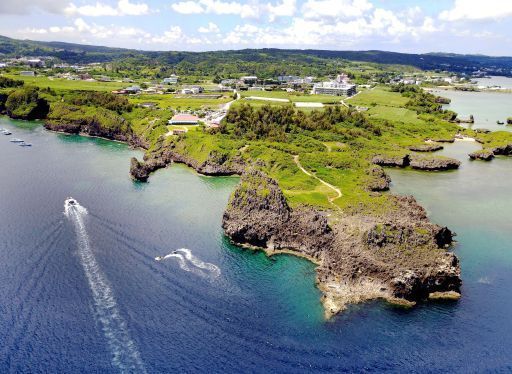Facing Serious Coral Damage and Parking Problems, Government Experiments with Limiting Leisure-Use of Okinawa’s Blue Cave

Cape Maeda is a popular spot for divers and has many international visitors (July 27, 2017, Maeda in Onna. Photograph taken by RC helicopter)
October 22, 2021 Ryukyu Shimpo
On October 21, the Okinawa General Bureau announced the start of an experimental project limiting use of the area around Cape Maeda in Onna for marine leisure purposes. The area is known to tourists inside and outside of Japan for excellent diving. For approximately one month, from November 8 through December 6, advance notice will be required before entering the water. There will also be limits on how long visitors can be there, and the number of visitors. With a sudden surge in tourists visiting Cape Maeda, coral reefs are being damaged and illegal parking is becoming a problem in the area. The General Bureau will use the project to consider future actions.
According to a representative of the General Bureau, this is the first time that limits have been placed on the use of a section of the ocean in Okinawa, and such steps are rare throughout Japan. Cape Maeda is a popular spot for diving and snorkeling, and is home to the so-called “Blue Cave.”
Overtourism, when too many tourists negatively impact the local environment and the lives of residents, is becoming a problem globally, and around Cape Maeda, has already resulted in problems such as damage to the marine ecosystem and traffic jams on roads that locals need for daily life. The General Bureau decided to carry out the experimental project in hopes of promoting marine tourism that is sustainable and brings high added value.
The experimental policy will affect the stretch of ocean accessible from Maeda and Yamada in Onna, an area that includes the Blue Cave. During the trial period, marine leisure businesses and members of the general public hoping to enter the water in this area will be required to submit a notification to the facilities management company. In order to improve congestion in the water and in public parking lots at the cape, each party will be limited to 100 minutes, and no more than 200 individuals will be allowed at one time.
In addition, parts of the area with coral reefs especially susceptible to damage will be off limits. These areas will later be compared with neighboring areas to see what impact such limits have in terms of environmental conservation.
Issues that emerge during the one-month experimental project will be organized and brought to a joint council made up of local government representatives and related businesses, who will discuss future solutions.
At the General Bureau regular press conference held in Naha on October 21, Director-General of Transportation Shigeru Yoneyama explained “We are asking visitors for their cooperation as we proceed with this experimental project. We hope to first demonstrate the value of the approach, and then determine what needs to be improved in practice.”
(English translation by T&CT and Ellen Huntley)
Previous Article:Okinawan Miki Nakamasu sets new Guinness World Record with incredible muscle strength, holding himself up in a “human carp flag” for 36 seconds
Next Article:Large amounts of fish are killed after swallowing pumice stones from undersea volcanic eruption, 14 Okinawan fisheries reeling from the damage as Okinawa and Japan coordinate on removal
[Similar Articles]
- Over 6.8 million people visit Ocean Expo and Shuri Castle
- Editorial: Base contamination information disclosure must precede land return plan
- Okinawa Governor approves landfill for extending runway of Naha Airport
- World record-holding free diver impressed with Oura Bay speaks up against land reclamation
- Okinawan personnel interacting with foreign tourists note language barrier as greatest challenge
 Webcam(Kokusai Street)
Webcam(Kokusai Street)


